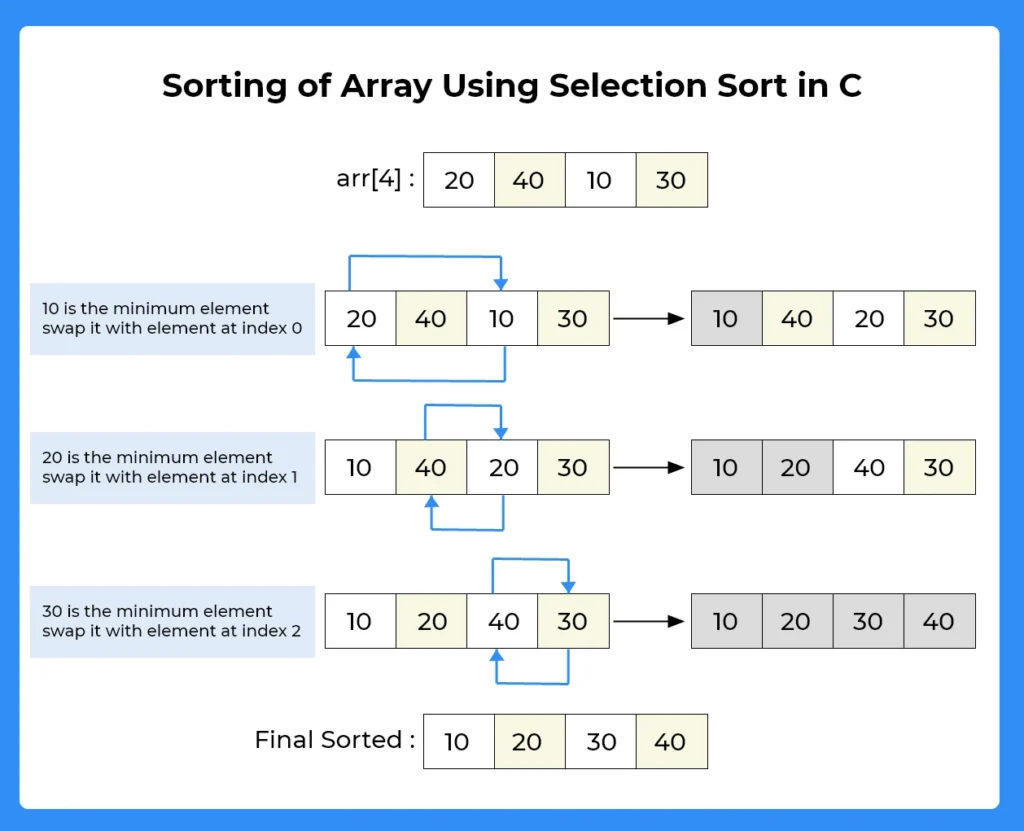Sorting of Array in C
Sorting of Array in C Language
In this page we will look into a coding question where we will learn about sorting of array in C programming language. There are many sorting techniques to sort the array like quick sort, merge sort, bubble sort, insertion sort and selection sort. There might be different approach to solve this question, one you will find here. If your approach is bit different post it onto the comment section.
Sorting of Array In C Programming
Problem Statement – How to arrange array in ascending order
Sorting is the process of arranging elements in a list or array in a specific order, typically in ascending or descending order. Sorting is a fundamental problem in computer science and has many applications in areas such as searching, data compression, and data analysis.
There are many sorting algorithms that can be used to sort an array. Some of the most popular algorithms include:
Bubble Sort: This is a simple sorting algorithm that repeatedly steps through the list, compares adjacent elements, and swaps them if they are in the wrong order.
Selection Sort: This algorithm sorts an array by repeatedly finding the minimum element from the unsorted part of the array and putting it at the beginning.
Insertion Sort: This algorithm builds the final sorted array one item at a time, by inserting each item in the correct position in the array.
Merge Sort: This algorithm divides the array into two halves, sorts each half separately, and then merges the two halves together to form a sorted array.
Quick Sort: This algorithm picks an element as a pivot and partitions the array around the pivot, such that elements smaller than the pivot are on one side and elements larger than the pivot are on the other side. It then recursively sorts the two sub-arrays.

Algorithm :
- Take the size of the array from the user.
- Declare an array of given input size.
- Take the input of all elements of the array.
- Now run a for loop from 0 to size-1.
- And for every element check it from all the next elements to it. If the element is greater than swap that number.
- In this way the array will get sorted in ascending order.
Program for sorting the elements of c in ascending order Using Selection Sort
#include<stdio.h>
int main()
{
int a[6]= {12,5,10,9,7,6};
int temp;
int i, j;
printf("Before Sorting ");
for(i=0; i<6; i++)
{
printf("%d ",a[i]);
}
for(i=0; i<6; i++)
{
for(j=i+1; j<6; j++) { if(a[i]>a[j])
{
temp = a[i];
a[i] = a[j];
a[j] = temp;
}
}
}
printf("\nAfter Sorting ");
for(i=0; i<6; i++)
{
printf("%d ",a[i]);
}
return 0;
}
Output:
Before Sorting 12 5 10 9 7 6 After Sorting 5 6 7 9 10 12



Login/Signup to comment